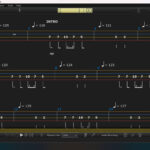Want to shred on Guitar Hero 2 for PS2 but short on compatible guitars? You might be surprised to learn that your trusty old PlayStation 1 controller holds the key. While a standard PS2 controller won’t work directly with Guitar Hero 2 (GH2) and later titles like Rocks the 80s, a simple modification using a PS1 pad can get you rocking. Interestingly, for the original Guitar Hero 1 (GH1), a PS2 pad is perfectly acceptable for creating a custom guitar. But GH2’s controller compatibility is more specific, requiring a digital controller with analog stick inputs, something the standard PS2 pad, despite its analog nature, doesn’t fully satisfy for this purpose. So, if GH2 and beyond compatibility is your goal, a PS1 controller is your best bet.
For this guide, we’ll be using a generic, third-party PS1 controller, chosen for its less desirable aesthetics – perfect for repurposing! Let’s dive into the wiring process to transform it into a functional Guitar Hero guitar.
Here’s a breakdown of the connection points you’ll need to solder:
- Left D-pad (Down Direction): Solder this as if it’s permanently pressed down. This crucial step signals to the PS2 console that you’re using a guitar controller. In-game, pressing down on the left d-pad will typically open the tutorial menu, confirming its function.
- GND (Ground): Essential for all switches. Fortunately, the PS1 controller PCB provides multiple ground outlets for easy access.
- Up D-pad: Connect this to the “strum up” action.
- L2 Button: This will handle the motion sensor input, which translates to “star power” activation in the game. There are two available outlets for the L2 button.
- Down D-pad: Connect this to the “strum down” action.
- Select Button: While its uses are limited, the Select button can also be mapped to “star power”.
- Start Button: Crucial for pausing the game and accessing the in-game menu.
- Square Button: This will function as the orange fret button. Note that some PS1 controller PCBs might lack a dedicated solder pad for the square button, requiring extra care when soldering.
- R2 Button: Connect this to the green fret button.
- Cross Button (X): This becomes your blue fret button.
- Circle Button: This will be the red fret button.
- Triangle Button: This is for the yellow fret button.
- Left Analog Stick (Y-axis): This will control the whammy bar. Connect it as a trimmer between GND (ground) and Ucc (voltage common collector).
- Ucc (Voltage Common Collector): Easily accessible on the PCB and needed for the whammy bar circuit.
These points will serve as your reference throughout the guitar building process.
Pro-Tip: Since rumble motors serve no purpose in Guitar Hero gameplay, removing them from the PS1 controller is recommended to simplify the build and potentially reduce weight.

